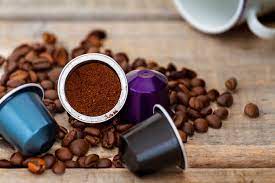How do you get your daily coffee and at what cost?

In the battle for your coffee dollar there are many suiters vying for your attention. And no wonder. The number of Americans drinking a daily cup of coffee is at the highest level since 2012, with demand continuing to get a boost from at-home consumption (fueled a lot by the pandemic) and an appetite for gourmet coffee drinks. Recent industry studies show that around 2 of 3 Americans, aged 18 or over, said they had a cup of coffee the previous day. Clearly, we and our neighbors are in a love affair with coffee.
Among the Americans surveyed, at-home preparation continues to be the dominant spot for demand, with 79 percent of those surveyed saying they had had a cup of coffee at home the previous day. Coffee consumed at cafes and other out-of-home locations totaled 36 percent.
The cost of coffee then and now
Prior to the invention of the K-cup and the rise of Starbucks and other cafe’s, home brewing was even more prevalent. Think of it this way. If you asked someone over 50 what the price of coffee was when they were in their 20’s they would probably speak of it in price per pound. Back then, you bought a can of coffee for $4 or $5. Ask a millennial today and they are more likely to say $3 a cup or maybe $4-5 for specialty drinks. This lead me to thinking about something perhaps overlooked by many coffee drinkers who get their caffeine at home. I am speaking of the cost of that quick, “pop a pod” in the single serve machine on the kitchen counter. So I did some research to check it out.
I found that convenience comes with a cost.
Several studies show that when you calculate the cost of these single serve pods and compare them to a pound of coffee, you find that good quality single serve runs around $50 per pound (NY Times) while most specialty coffees average $20 or less per pound. Are K-cups convenient – yes. Pricey – YES and YES! The first capital yes has to do with the coffee itself. Typical studies show a K-cup costs average around 65 cents per cup to make. Yes, there are cheaper K-cups, but who wants to drink cheap coffee! Compare that with a $20 per pound, or less, for specialty coffee at around 44 cents per cup. That is a huge disparity for the convenience your Keurig or Nespresso provides.

Here’s a quick comparison of K-Cup Brewing versus regular Drip Brewing over the course of a year, using the standard recommendation of two tablespoons of ground coffee for making a six-ounce cup.
- 2 tablespoons ground coffee = 10 grams. A 1 lb. bag of coffee is 453 grams.
- That means we get45 six-ounce cups out of that one bag (453/10).
If you drink a cup a day, you will go through a little over eight bags a year (365 days/45 cups), amounting to $160 spent on coffee (8 bags*$20 (the cost of the average 1 lb. specialty coffee).
Consuming the equivalent amount in K-Cups adds up to $400 a year (8 lbs*$50, the average price per pound of K-Cup coffee), over 2 1/2 times as much.
Realistically — most of us are probably drinking more coffee than that. The Specialty Coffee Association (SCA) reports that the average American consumes between 2-3 cups per day. So, conservatively doubling our 1 cup a day numbers to $320 per year for the Drip Brewing and $800 for the K-Cup Brewing, that’s an even bigger dent in the wallet.
The second capital yes has to do with the environment. While there is a move to create pods that are totally biodegradable or to employ reusable pod/filter combos, most K-cup consumption is from coffee pods in pre-filled plastic containers. Millions of these are disposed of in landfills every year. And to further emphasize the point about cost, here is a quote from John Sylvan, inventor of the Keurig and K-cup:
“I don’t have one. They’re kind of expensive to use,” Sylvan said of the K-Cup system he created. “Plus, it’s not like drip coffee is tough to make.”

Conclusion
If your bottom line is convenience, the pod seems like a logical choice. If you are more concerned about the higher cost or the environmental impact of that convenience, then you might want to consider another brewing method. And we didn’t even explore the better tasting coffee other brewing methods produce. A better cup of coffee can be had at a better price point and it's not that hard to make. But whatever method you choose to brew your coffee, I think it’s always good to look a little deeper into the choices we have. In the meantime, stay caffeinated and enjoy another cup!

Leave a comment